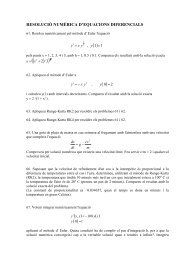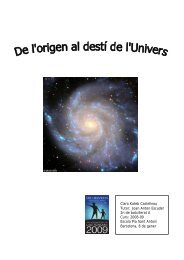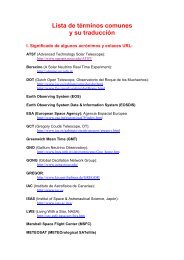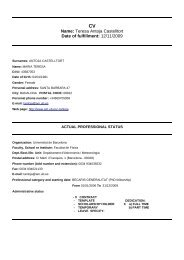Universitat de - Departament d'Astronomia i Meteorologia ...
Universitat de - Departament d'Astronomia i Meteorologia ...
Universitat de - Departament d'Astronomia i Meteorologia ...
Create successful ePaper yourself
Turn your PDF publications into a flip-book with our unique Google optimized e-Paper software.
46 Chapter 2. Multiwavelength approach to LS 5039<br />
hence supporting the mechanism of synchrotron radiation as the responsible for the<br />
<strong>de</strong>tected radio emission.<br />
Excluding false data due to technical or weather problems, LS 5039 does not<br />
show day-to-day variability larger than ∼ 30%, and no strong radio outbursts have<br />
been <strong>de</strong>tected. No orbital period is <strong>de</strong>tected in the GBI data in the range between<br />
2 and 100 days. In general terms, the observed radio behavior confirms the earlier<br />
suggestions by Martí et al. (1998) concerning the persistent and mo<strong>de</strong>rately variable<br />
nature of the radio emission.<br />
2.4.4 VLBA observations, discovery of a microquasar<br />
As we have seen in Sect. 2.4.2, LS 5039 appeared unresolved to the VLA in A<br />
configuration, i.e., with a size ≤ 0.1 ′′ . On the other hand, a lower limit to the source<br />
size of ≥ 0.2 mas was <strong>de</strong>rived to prevent catastrophic inverse Compton losses to<br />
occur. Therefore, we <strong>de</strong>ci<strong>de</strong>d to conduct observations using the Very Long Baseline<br />
Interferometry (VLBI) technique, aimed to reveal the mas structure of the source.<br />
Observations and results<br />
We observed 11 LS 5039 at 5 GHz frequency (6 cm wavelength) on 1999 May 8<br />
(MJD 51306) with the 10×25-m antennas of the NRAO 12 Very Long Baseline Array<br />
(VLBA) and the 27×25-m antennas of the VLA in its phased array mo<strong>de</strong> in its D<br />
configuration. In this mo<strong>de</strong>, the VLA has the same sensitivity as a dish of ∼ 115 m<br />
diameter, and provi<strong>de</strong>s sensitive baselines with the VLBA antennas. The VLA<br />
phasing process was successful, and it worked without problems as another VLBI<br />
station. On the other hand, in theory the VLA could also record data on its own.<br />
This would allow to perform a very sensitive VLA map and to follow the radio flux<br />
<strong>de</strong>nsity during the VLBA run. However, there was an air conditioning failure in the<br />
VLA correlator, and it could not record data.<br />
The source 3C 345 was used as a fringe-fin<strong>de</strong>r, whereas J1733−1304 was the<br />
phasing source for the VLA. We could not use the VLBI phase-reference technique<br />
11 Published in Pare<strong>de</strong>s, J. M., Martí, J., Ribó, M., & Massi, M. 2000, Science, 288, 2340.<br />
12 The National Radio Astronomy Observatory is a facility of the USA National Science Foun-<br />
dation operated un<strong>de</strong>r cooperative agreement by Associated Universities, Inc.






